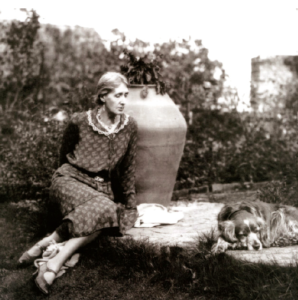Ernest Hemingway. Virginia Woolf. Stephen King. They’re all literary greats—and they’re also animal lovers. Many photos show them in a different light: hugging a cat, running after a dog, petting a bird. Some writers bring their love of their pets into their work, immortalizing them in literature. Some of these literary pets even make an appearance on the silver screen.
Cat People
The Internet loves cats, and so do many writers. One of the most famous cat people you’re going to find is Ernest Hemingway. He and his then-wife Pauline bought a house in Key West, Florida in 1931, and by 1945, they had 23 cats. His fourth wife, Mary, called the cats “purr factories” and “love sponges.”
The Key West home is now a museum, open to visitors. When you get there, you’re going to see the descendants of Hemingway’s cats. According to hemingwayhome.com, “The Ernest Hemingway Home and Museum is home to approximately 40-50 polydactyl (six-toed) cats. Ernest Hemingway was given a white six-toed cat by a ship’s captain and some of the cats who live on the museum grounds are descendants of that original cat, named Snow White.”

Neil Gaiman is also a cat person. His “Smoke and Mirrors” has a short story titled, “The Price,” about a mysterious black cat: “That cat, my wife had said, when he first arrived, is a person. And there was something very person-like in his huge, leonine face: his broad black nose, his greenish-yellow eyes, his fanged but amiable mouth (still leaking amber pus from the right lower lip).” The cat defends the home from a mysterious evil, and at the end of the story, the speaker asks how much more the injured, crippled cat can give to continue protecting them.
There are also posts on Gaiman’s blog about his family’s cats. Back in 2010, he devoted several entries to their sick cat, Zoe. He wrote, “The news is as bad as it could be. It’s a tumour, it’s huge, it’s malignant, it’s rare, it’s extremely fast-growing.
There’s only been one case where they even tried operating on a cat to remove it, and the cat died the next day. I want her to come home from the hospital, and die peacefully among people who love her. Two cats died last year – Pod and Hermione – but they were eighteen, and so old it was a mercy of sorts, and was expected. I was sad, but their deaths just felt like the final page had turned. This one hurts.”
If you’re a fan of both classic Hollywood movies and cats, then you should look up Colette, French novelist and “the original Cat Woman,” whose novel “Gigi” was adapted for the stage and the screen.
“Colette wrote a novel entitled ‘The Cat,’ which is about the engagement and honeymoon of a couple who is divided over the man’s helpless devotion to his cat, Saha. Colette’s cat lover, Alain, muses in the book ‘It wasn’t just a little cat I was carrying at that moment,’ Alain mused. ‘It was the incarnate nobility of the whole cat race, her limitless indifference, her tact, her bond of union with the human aristocrat.’”
Dog Lovers
Of course, there are just as many authors who prefer dogs. Master of terror Stephen King is credited with saying, “It might be that the biggest division in the world isn’t men and women but folks who like cats and folks who like dogs.”
It was in December 2014 when he first posted pictures of the Corgi named Molly, affectionately nicknamed “The Thing of Evil.” While too cute to be a Cujo (that fearsome dog from an early novel), Molly’s photos dominate King’s social media posts, with adorable captions that only a writer of horror could think of, such as, “The Thing of Evil ruthlessly hunts down the Purple Dinosaur of Decency and crows over its dead body.”
For more classic authors and their beloved canines, look up Maureen Adams’ book, “Shaggy Muses: The Dogs Who Inspired Virginia Woolf, Emily Dickinson, Elizabeth Barrett Browning, Edith Wharton, And Emily Brontë.” From the book blurb, “’You’ll call this sentimental—perhaps—but then a dog somehow represents the private side of life, the play side,’ Virginia Woolf confessed to a friend.” Her dog was named Pinka.

One of Woolf’s lesser-known works is “Flush: A Biography,” about the English poet Elizabeth Barrett Browning and her cocker spaniel, Flush. “Woolf writes the entirety of the book from Flush’s perspective, and it is very much ‘his’ account of it. Flush is not relegated to the one-dimensional position of being just Barrett Browning’s pet,” Woolf wrote.
Flush was very much a part of Barrett Browning’s life, and was the subject of one of her poems, “To Flush, My Dog.” He appeared in “The Barretts of Wimpole Street,” a 1930 play recounting the romance between Barrett and Robert Browning, as well as the 1934 and 1957 film adaptations.
Even after Barrett Browning gave birth to her first child, Flush was never neglected. She wrote in a letter, “Meanwhile Flush loses nothing I assure you. On the contrary, he is hugged and kissed (rather too hard sometimes), and never is permitted to be found fault with by anybody under the new regime. If Flush is scolded, Baby cries as matter of course.”
If you look hard enough, you’ll find even more stories of authors and their pets, touching, funny, heart-warming. What’s your favorite?
This appeared in Animal Scene’s October 2015 issue.






